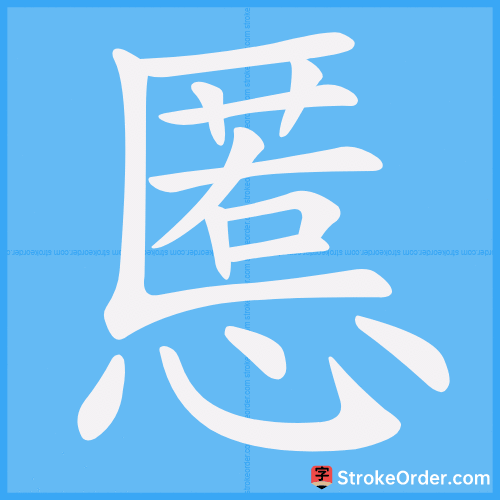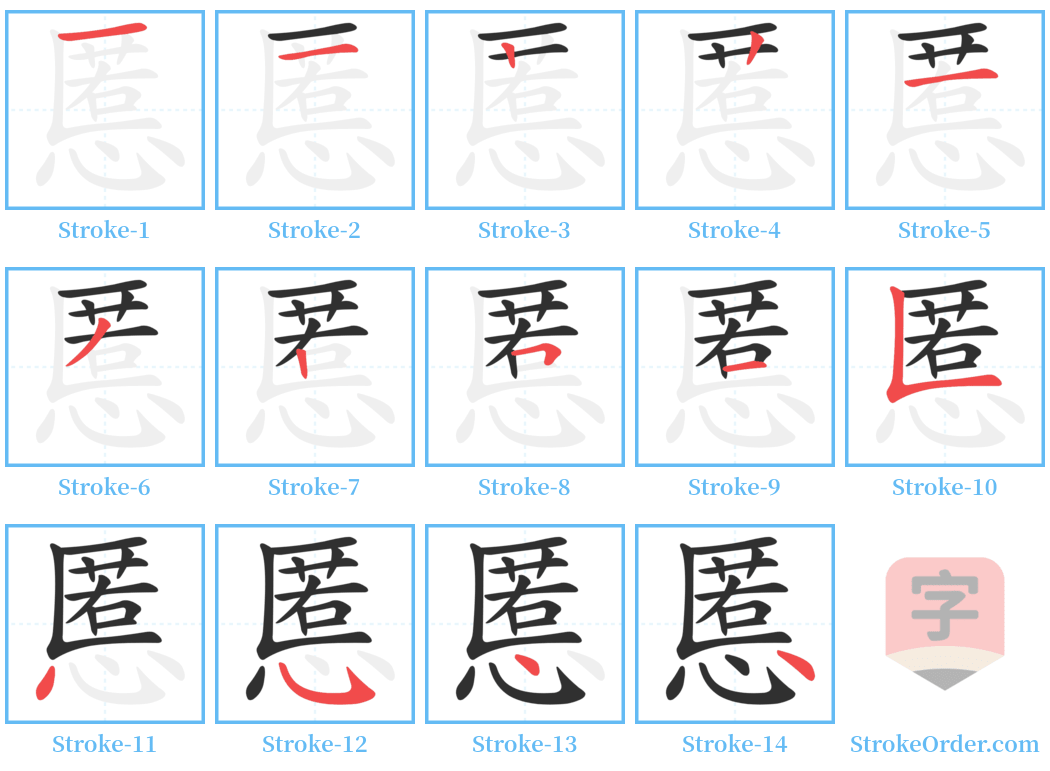慝 Stroke Order
Animated Stroke Order of 慝

Stroke Order Diagrams for 慝

Step-by-Step Handwriting Guide for 慝

Learn to Write Chinese Characters with Video Tutorials
Watch the video of writing the Chinese character "慝", learn the correct stroke order (笔顺) of the character "慝", and master the standard way of writing the character "慝".
Free Printable Handwriting Practice with Stroke Order: 慝
Printable Writing Practice Worksheet of "慝" in Portrait Orientation (Tian Zi Ge)

Printable Writing Practice Worksheet of "慝" in Landscape Orientation (Tian Zi Ge)

Information of 慝
Pinyin
tè
Radical
心
Strokes
14 strokes
Usage
★★★★
Definition
evil thought
慝 [tè]
词性:名词
1. 奸邪,邪恶。
Wickedness, evil.
2. 阴气。
Overcast.
3. 灾害。
Calamity: "以伏蛊慝" (To subdue evils with sorcery).
引证:
1. 《尔雅》:崇谗慝也。释文:“慝,言隐匿其情以饰非。”
- From "Erya": To praise slanderous wickedness means to hide one's feelings to mask wrongdoing.
2. 《周礼·环人》:察军慝。注:“慝,阴奸也。”
- From "Zhou Li": To scrutinize military evil. Note: "慝" refers to hidden treachery.
3. 《左传·僖公十五年》:于是展氏有隐慝焉。注:“阴恶,非法所得。”
- From "Zuo Zhuan": Thus, there are hidden evils in the Zhan family. Note: "陰恶" implies wrongful gain.
4. 《左传·昭公二十五年》:日入慝作。注:“奸恶也。”
- From "Zuo Zhuan": At sunset, treachery occurs. Note: "奸恶" means wicked actions.
5. 《周礼·匡人》:匡邦国而观其慝。注:“奸伪之恶也。”
- From "Zhou Li": To regulate the nation and observe its vile behavior. Note: It refers to treacherous and deceitful evils.
6. 唐·刘叉《雪车》:天子端然少旁求,股肱耳目皆奸慝。
- From Tang's Liu Cha's "Snow Carriage": The emperor is calm and seeks little, yet his close advisors are all treacherous.
例:
又如: 慝人(邪恶的人); 慝作(奸恶之人乘机而起); 慝伪(奸伪); 慝礼(不正之礼)
For example: 慝人 (evil person); 慝作 (wicked person taking advantage); 慝伪 (treachery); 慝礼 (improper customs).
2. 灾害。
Calamity.
引证:
1. 《国语》:以伏蛊慝。
- From "Guo Yu": Subduing evils with sorcery.
3. 恶人; 坏人。
Villain.
引证:
1. 《管子》:如此,则国平而民无慝矣。
- From "Guanzi": In this way, the nation will be peaceful and the people without villains.
4. 阴气。
Overcast.
引证:
1. 唯正月之朔,慝未作。——《左传》注:“慝,阴气也。”
- Only on the first day of the lunar month does the evil not emerge. — From "Zuo Zhuan" note: "慝" means overcast.
5. 瘴气蛊毒之类。
Miasma.
引证:
1. 《周礼·土训》:道地慝。注:“地慝,若障蛊然也。”司农注:“地所生恶物害人者。若虺蝮之属。”
- From "Zhou Li": Evil of the land. Note: It means harmful things born of the earth, like venomous snakes.
6. 禁讳的语言。
Tabooed words.
引证:
1. 《周礼》:掌道方慝,以诏辟忌,以知地俗。郑玄注:“方慝,四方言语所恶也。”
- From "Zhou Li": To master tabooed words to issue warnings and to know the local customs.
7. 差错。
Mistake.
引证:
1. 《国语》:有过慝之度。
- From "Guo Yu": There are measures of error.
动词:慝 [tè]
词性:动词
1. 变更,差错。通“忒”。
Change, error. Common form "忒".
引证:
1. 《诗·鄘风·伯舟》:之死矢靡慝。
- From "Shijing": In death, the arrows did not miss.
2. 《诗·大雅·瞻卬》:岂曰不极?伊胡为慝!
- From "Shijing": Do we say it is not extreme? Why then act wrongly?
3. 《国语·周语下》:有过慝之度。
- From "Guo Yu": There are measures of error.
4. 《汉书·王嘉传》:人用侧颇辟,民用僭慝。颜师古云:“慝,恶也。”
- From "Han Shu": People use side roads; the people practice villainy. Yan Shigu notes: "慝" means evil.
2. 通“匿”。隐藏。
Hide, common form "匿".
引证:
1. 《墨子·尚贤下》:隐慝良道,而不相教诲。
- From "Mozi": To hide good ways without teaching one another.
2. 《汉书·五行志下之下》:朔而月见东方,谓之仄慝。
- From "Han Shu": At the new moon, when it appears in the east, it is called slope evil.
Input Method for 慝
Pinyin
te4
Wubi
aadn
Cangjie
srp
Zhengma
hejw
Four Corner
71331
Unicode
U+615d